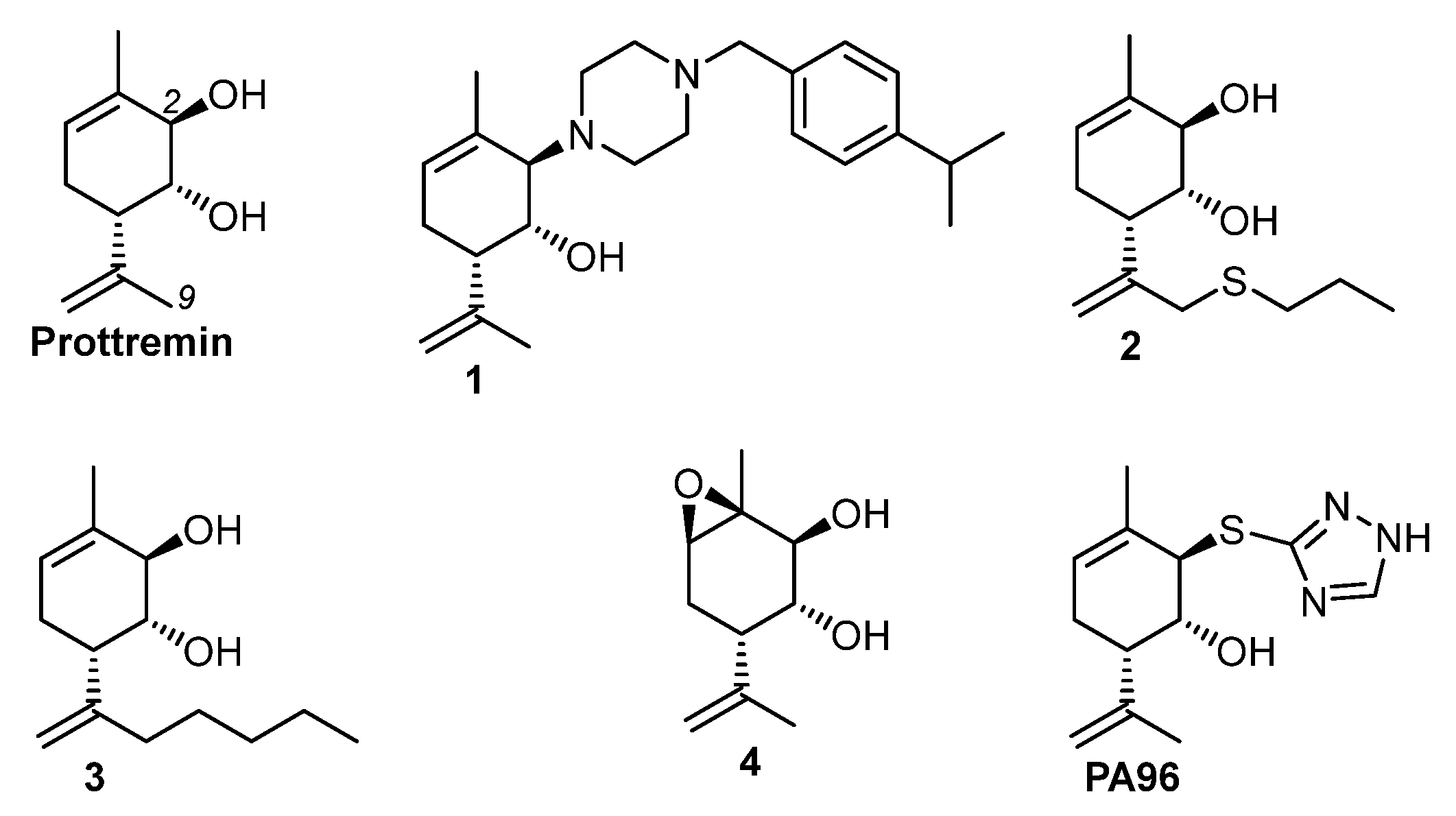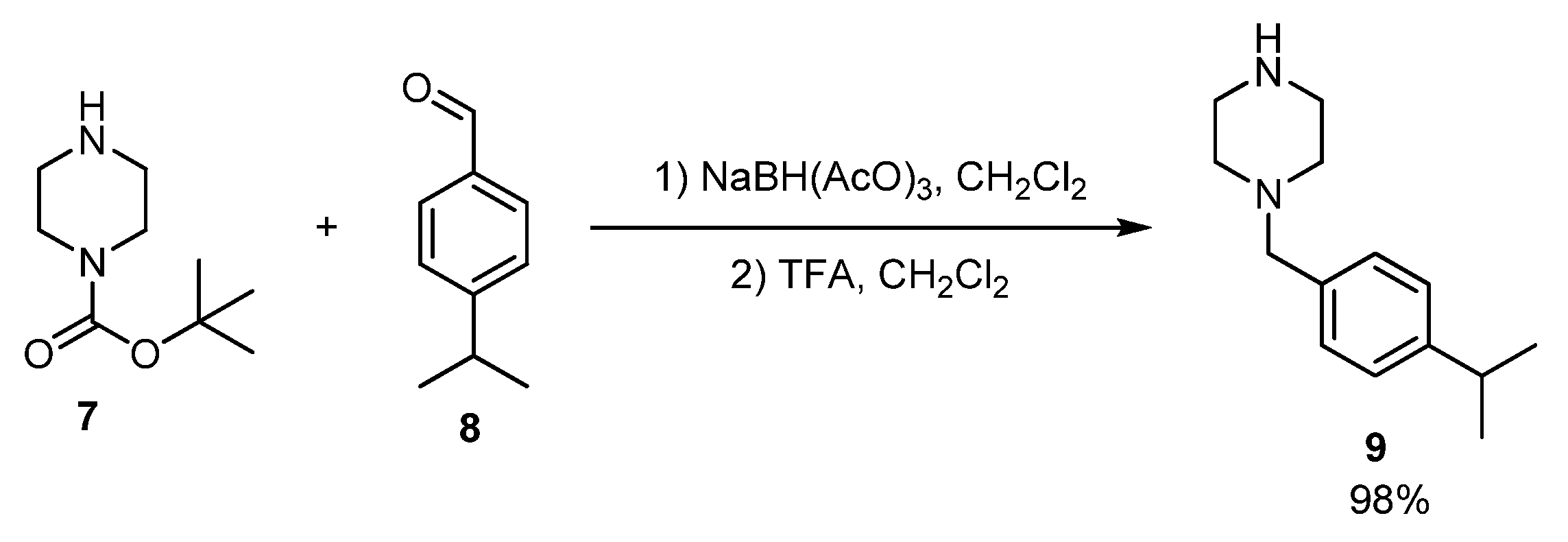(1R,2R,6S)-2(4-(4-Isopropylbenzyl)piperazin-1-yl)-3-methyl-6-(prop-1-en-2-yl)cyclohex-3-enol
Abstract
:1. Introduction
2. Results and Discussion
3. Materials and Methods
3.1. General
3.2. Synthesis of 1-(4-Isopropylbenzyl)piperazine 9
3.3. Synthesis of (1R,2R,6S)-2-(4-(4-Isopropylbenzyl)piperazin-1-yl)-3-methyl-6-(prop-1-en-2-yl)cyclohex-3-en-1-ol 1
4. Conclusions
Supplementary Materials
Author Contributions
Funding
Data Availability Statement
Acknowledgments
Conflicts of Interest
References
- Bloem, B.R.; Okun, M.S.; Klein, C. Parkinson’s disease. Lancet 2021, 397, 2284–2303. [Google Scholar] [CrossRef] [PubMed]
- Cacabelos, R. Parkinson’s Disease: From Pathogenesis to Pharmacogenomics. Int. J. Mol. Sci. 2017, 18, 551. [Google Scholar] [CrossRef] [PubMed]
- Ardashov, O.V.; Pavlova, A.V.; Il’ina, I.V.; Morozova, E.A.; Korchagina, D.V.; Karpova, E.V.; Volcho, K.P.; Tolstikova, T.G.; Salakhutdinov, N.F. Highly Potent Activity of (1R,2R,6S)-3-Methyl-6-(prop-1-en-2-yl)cyclohex-3-ene-1,2-diol in Animal Models of Parkinson’s Disease. J. Med. Chem. 2011, 54, 3866–3874. [Google Scholar] [CrossRef] [PubMed]
- Valdmana, E.; Kapitsa, I.; Ivanova, E.; Voronina, T.; Ardashov, O.; Volcho, K.; Khazanov, V.; Salakhutdinov, N. Evolution of anti-parkinsonian activity of monoterpenoid (1R,2R,6S)-3- methyl-6-(prop-1-en-2-yl)cyclohex-3-ene-1,2-diol in various in vivo models. Eur. J. Pharmacol. 2017, 815, 351–363. [Google Scholar] [CrossRef] [PubMed]
- Ardashov, O.V.; Pavlova, A.V.; Korchagina, D.V.; Volcho, K.P.; Tolstikova, T.G.; Salakhutdinov, N.F. 3-Methyl-6-(Prop-1-En-2-Yl) Cyclohex-3-Ene-1,2-Diol: The Importance of Functional Groups for Antiparkinsonian Activity. Med. Chem. 2013, 9, 731–739. [Google Scholar] [CrossRef] [PubMed]
- Ardashov, O.; Pavlova, A.; Korchagina, D.; Volcho, K.; Tolstikova, T.; Salakhutdinov, N. Antiparkinsonian Activity of Some 9-N-, O-, S- and C-Derivatives of 3-Methyl-6-(Prop-1-En-2-Yl) Cyclohex-3-Ene-1,2-Diol. Bioorg. Med. Chem. 2013, 21, 1082–1087. [Google Scholar] [CrossRef] [PubMed]
- Ardashov, O.V.; Pavlova, A.V.; Mahato, A.K.; Sidorova, Y.; Morozova, E.A.; Korchagina, D.V.; Salnikov, G.E.; Genaev, A.M.; Patrusheva, O.S.; Li-Zhulanov, N.S.; et al. A Novel Small Molecule Supports the Survival of Cultured Dopamine Neurons and May Restore the Dopaminergic Innervation of the Brain in the MPTP Mouse Model of Parkinson’s Disease. ACS Chem. Neurosci. 2019, 10, 4337–4349. [Google Scholar] [CrossRef] [PubMed]
- Kotlyarova, A.; Podturkina, A.V.; Pavlova, A.V.; Gorina, D.S.; Lastovka, A.V.; Ardashov, O.V.; Rogachev, A.D.; Izyurov, A.E.; Arefieva, A.B.; Kulikov, A.V.; et al. Newly Identified Monoterpenoid-Based Small Molecule Able to Support the Survival of Primary Cultured Dopamine Neurons and Alleviate MPTP-Induced Toxicity In Vivo. Molecules 2022, 27, 8286. [Google Scholar] [CrossRef] [PubMed]
- Ardashov, O.; Zarubaev, V.; Shtro, A.; Korchagina, D.; Volcho, K.; Salakhutdinov, N.; Kiselev, O. Antiviral Activity of 3-Methyl-6-(prop-1-en-2-yl) Cyclohex-3-ene-1,2-diol and Its Derivatives against Influenza A(H1N1) 2009 Virus. Lett. Drug Des. Discov. 2011, 8, 375–380. [Google Scholar] [CrossRef]
- Paul, J. Procaspase-Activating Compounds and Compositions. U.S. Patent No. US 2013/0096133 A1, 18 April 2013. Available online: https://worldwide.espacenet.com/patent/search/family/048086390/publication/US2013096133A1?q=US20130096133A1 (accessed on 28 October 2022).
- Balahbib, A.; El Omari, N.; El Hachlafi, N.; Lakhdar, F.; el Menyiy, N.; Salhi, N.; Naceiri Mrabti, H.; Bakrim, S.; Zengin, G.; Bouyahya, A. Health beneficial and pharmacological properties of p-cymene. Food Chem. Toxicol. 2021, 153, 112259. [Google Scholar] [CrossRef] [PubMed]
- Rathi, A.K.; Syed, R.; Shin, H.-S.; Patel, R.V. Piperazine derivatives for therapeutic use: A patent review (2010–present). Expert Opin. Ther. Pat. 2016, 26, 777–797. [Google Scholar] [CrossRef] [PubMed]




Disclaimer/Publisher’s Note: The statements, opinions and data contained in all publications are solely those of the individual author(s) and contributor(s) and not of MDPI and/or the editor(s). MDPI and/or the editor(s) disclaim responsibility for any injury to people or property resulting from any ideas, methods, instructions or products referred to in the content. |
© 2023 by the authors. Licensee MDPI, Basel, Switzerland. This article is an open access article distributed under the terms and conditions of the Creative Commons Attribution (CC BY) license (https://creativecommons.org/licenses/by/4.0/).
Share and Cite
Podturkina, A.V.; Li-Zhulanov, N.S.; Volcho, K.P.; Salakhutdinov, N.F. (1R,2R,6S)-2(4-(4-Isopropylbenzyl)piperazin-1-yl)-3-methyl-6-(prop-1-en-2-yl)cyclohex-3-enol. Molbank 2023, 2023, M1546. https://doi.org/10.3390/M1546
Podturkina AV, Li-Zhulanov NS, Volcho KP, Salakhutdinov NF. (1R,2R,6S)-2(4-(4-Isopropylbenzyl)piperazin-1-yl)-3-methyl-6-(prop-1-en-2-yl)cyclohex-3-enol. Molbank. 2023; 2023(1):M1546. https://doi.org/10.3390/M1546
Chicago/Turabian StylePodturkina, Alexandra V., Nikolai S. Li-Zhulanov, Konstantin P. Volcho, and Nariman F. Salakhutdinov. 2023. "(1R,2R,6S)-2(4-(4-Isopropylbenzyl)piperazin-1-yl)-3-methyl-6-(prop-1-en-2-yl)cyclohex-3-enol" Molbank 2023, no. 1: M1546. https://doi.org/10.3390/M1546
APA StylePodturkina, A. V., Li-Zhulanov, N. S., Volcho, K. P., & Salakhutdinov, N. F. (2023). (1R,2R,6S)-2(4-(4-Isopropylbenzyl)piperazin-1-yl)-3-methyl-6-(prop-1-en-2-yl)cyclohex-3-enol. Molbank, 2023(1), M1546. https://doi.org/10.3390/M1546






